Strategic Financial Management Report: Ridley Co. Investment Analysis
VerifiedAdded on 2023/01/11
|10
|3759
|62
Report
AI Summary
This report presents a strategic financial management analysis of Ridley Co.'s proposed investment project. It begins with a critical evaluation of the net present value (NPV) method as a key analytical tool in capital investment appraisal, demonstrating its use in determining the financial viability of projects. The report then discusses the principle uncertainties associated with the project, such as potential decreases in cash inflow and reduced shareholder interest, and explores possible actions Ridley Co. could take to mitigate these risks and increase shareholder value, including investing in projects aligned with the same business line and offering higher dividends. Finally, the report critiques the implications of the organization using 100% debt funding to finance the project, considering the potential financial instability and impact on shareholder value.

Strategic financial
management
management
Paraphrase This Document
Need a fresh take? Get an instant paraphrase of this document with our AI Paraphraser

Table of Contents
Table of Contents.............................................................................................................................2
INTRODUCTION...........................................................................................................................1
MAIN BODY..................................................................................................................................1
Question 1: Critical evaluation of use of net present value method as the key analytical tool in
capital investment appraisal.........................................................................................................1
Question 2: Discussion of the principle uncertainties associated with the project......................3
Question 3: Discussion of possible actions that could be taken by the organisation to reduce
risk that the project fails to increase shareholder value...............................................................4
Question 4: Critique of the main issues of the organisation using 100% debt funding to finance
the project....................................................................................................................................5
CONCLUSION................................................................................................................................7
REFERENCES................................................................................................................................8
Table of Contents.............................................................................................................................2
INTRODUCTION...........................................................................................................................1
MAIN BODY..................................................................................................................................1
Question 1: Critical evaluation of use of net present value method as the key analytical tool in
capital investment appraisal.........................................................................................................1
Question 2: Discussion of the principle uncertainties associated with the project......................3
Question 3: Discussion of possible actions that could be taken by the organisation to reduce
risk that the project fails to increase shareholder value...............................................................4
Question 4: Critique of the main issues of the organisation using 100% debt funding to finance
the project....................................................................................................................................5
CONCLUSION................................................................................................................................7
REFERENCES................................................................................................................................8
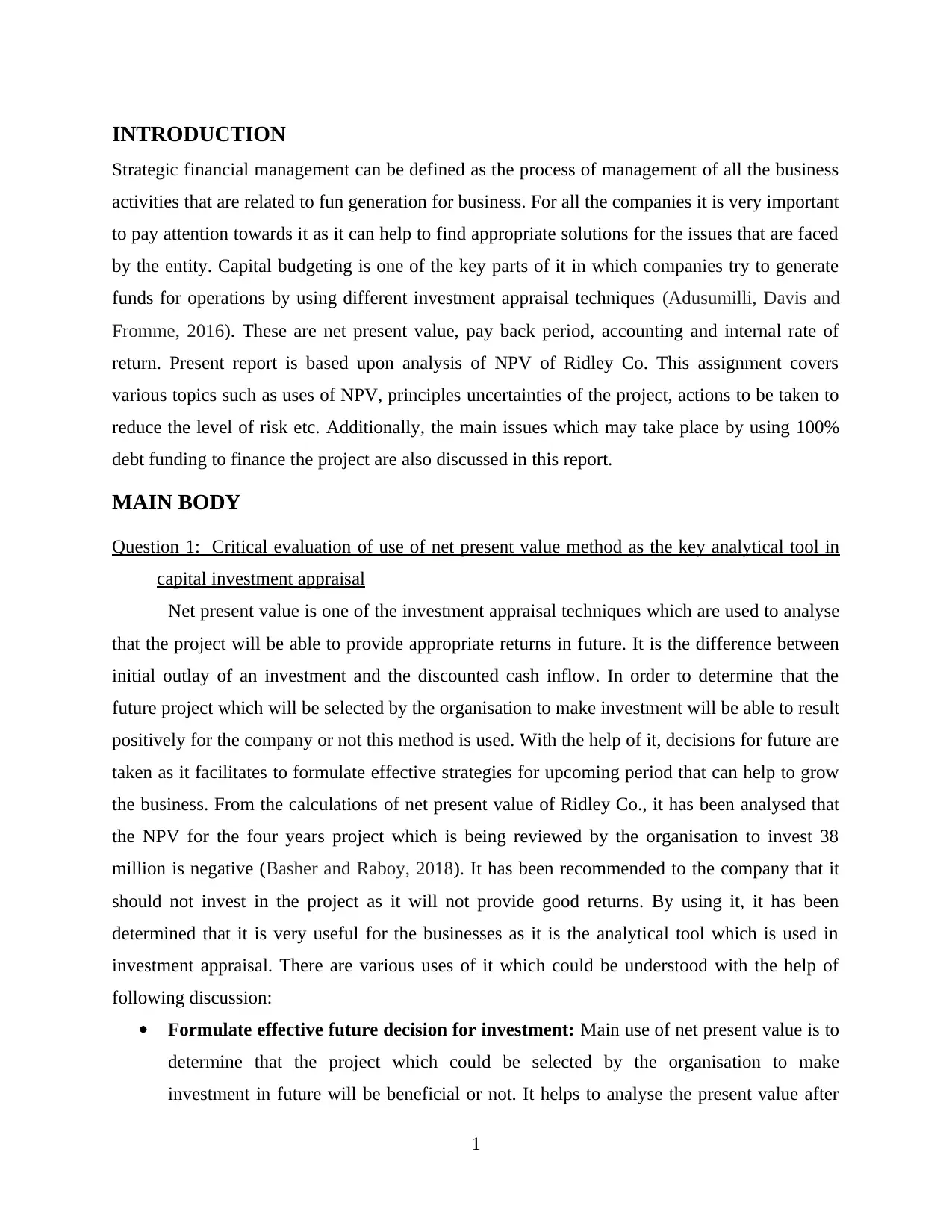
INTRODUCTION
Strategic financial management can be defined as the process of management of all the business
activities that are related to fun generation for business. For all the companies it is very important
to pay attention towards it as it can help to find appropriate solutions for the issues that are faced
by the entity. Capital budgeting is one of the key parts of it in which companies try to generate
funds for operations by using different investment appraisal techniques (Adusumilli, Davis and
Fromme, 2016). These are net present value, pay back period, accounting and internal rate of
return. Present report is based upon analysis of NPV of Ridley Co. This assignment covers
various topics such as uses of NPV, principles uncertainties of the project, actions to be taken to
reduce the level of risk etc. Additionally, the main issues which may take place by using 100%
debt funding to finance the project are also discussed in this report.
MAIN BODY
Question 1: Critical evaluation of use of net present value method as the key analytical tool in
capital investment appraisal
Net present value is one of the investment appraisal techniques which are used to analyse
that the project will be able to provide appropriate returns in future. It is the difference between
initial outlay of an investment and the discounted cash inflow. In order to determine that the
future project which will be selected by the organisation to make investment will be able to result
positively for the company or not this method is used. With the help of it, decisions for future are
taken as it facilitates to formulate effective strategies for upcoming period that can help to grow
the business. From the calculations of net present value of Ridley Co., it has been analysed that
the NPV for the four years project which is being reviewed by the organisation to invest 38
million is negative (Basher and Raboy, 2018). It has been recommended to the company that it
should not invest in the project as it will not provide good returns. By using it, it has been
determined that it is very useful for the businesses as it is the analytical tool which is used in
investment appraisal. There are various uses of it which could be understood with the help of
following discussion:
Formulate effective future decision for investment: Main use of net present value is to
determine that the project which could be selected by the organisation to make
investment in future will be beneficial or not. It helps to analyse the present value after
1
Strategic financial management can be defined as the process of management of all the business
activities that are related to fun generation for business. For all the companies it is very important
to pay attention towards it as it can help to find appropriate solutions for the issues that are faced
by the entity. Capital budgeting is one of the key parts of it in which companies try to generate
funds for operations by using different investment appraisal techniques (Adusumilli, Davis and
Fromme, 2016). These are net present value, pay back period, accounting and internal rate of
return. Present report is based upon analysis of NPV of Ridley Co. This assignment covers
various topics such as uses of NPV, principles uncertainties of the project, actions to be taken to
reduce the level of risk etc. Additionally, the main issues which may take place by using 100%
debt funding to finance the project are also discussed in this report.
MAIN BODY
Question 1: Critical evaluation of use of net present value method as the key analytical tool in
capital investment appraisal
Net present value is one of the investment appraisal techniques which are used to analyse
that the project will be able to provide appropriate returns in future. It is the difference between
initial outlay of an investment and the discounted cash inflow. In order to determine that the
future project which will be selected by the organisation to make investment will be able to result
positively for the company or not this method is used. With the help of it, decisions for future are
taken as it facilitates to formulate effective strategies for upcoming period that can help to grow
the business. From the calculations of net present value of Ridley Co., it has been analysed that
the NPV for the four years project which is being reviewed by the organisation to invest 38
million is negative (Basher and Raboy, 2018). It has been recommended to the company that it
should not invest in the project as it will not provide good returns. By using it, it has been
determined that it is very useful for the businesses as it is the analytical tool which is used in
investment appraisal. There are various uses of it which could be understood with the help of
following discussion:
Formulate effective future decision for investment: Main use of net present value is to
determine that the project which could be selected by the organisation to make
investment in future will be beneficial or not. It helps to analyse the present value after
1
⊘ This is a preview!⊘
Do you want full access?
Subscribe today to unlock all pages.

Trusted by 1+ million students worldwide
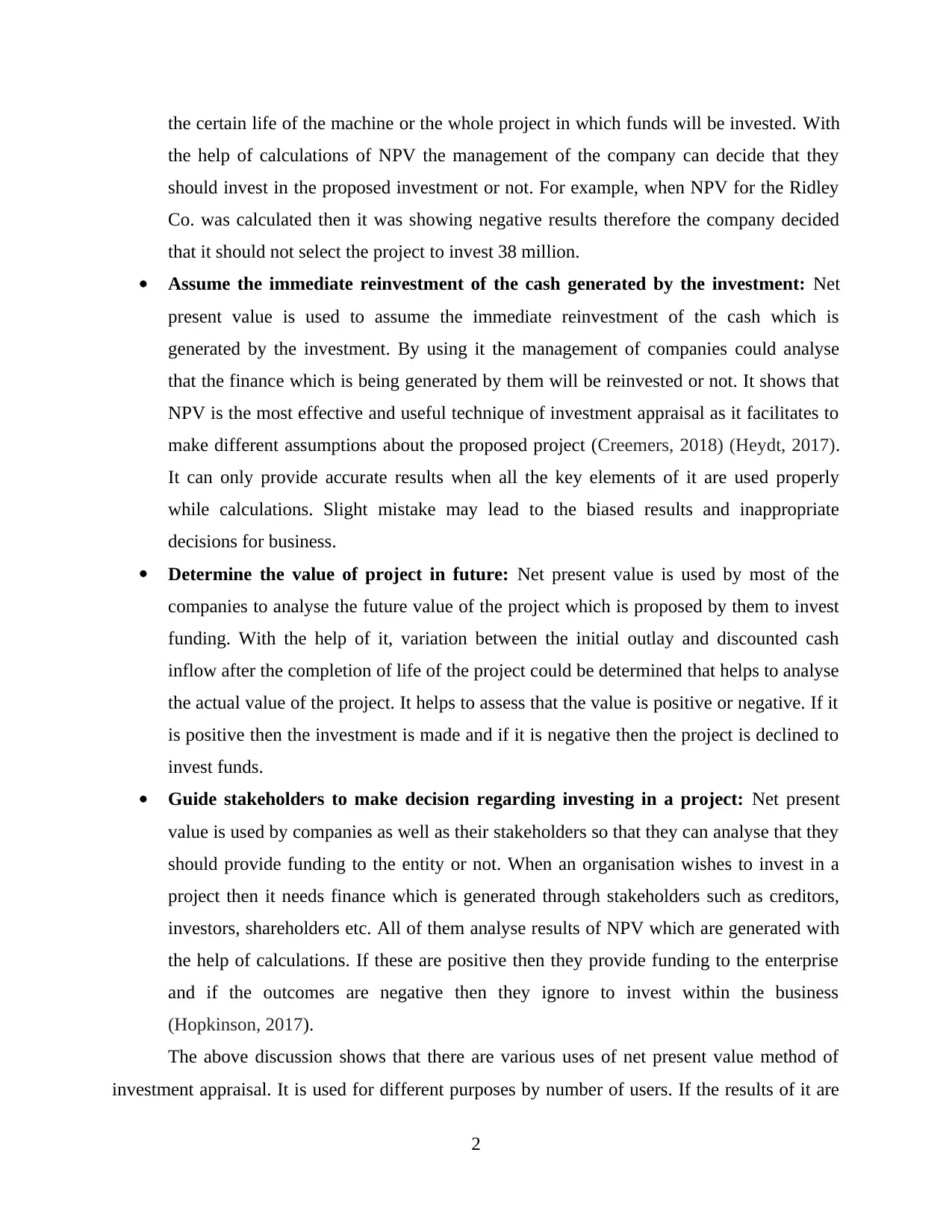
the certain life of the machine or the whole project in which funds will be invested. With
the help of calculations of NPV the management of the company can decide that they
should invest in the proposed investment or not. For example, when NPV for the Ridley
Co. was calculated then it was showing negative results therefore the company decided
that it should not select the project to invest 38 million.
Assume the immediate reinvestment of the cash generated by the investment: Net
present value is used to assume the immediate reinvestment of the cash which is
generated by the investment. By using it the management of companies could analyse
that the finance which is being generated by them will be reinvested or not. It shows that
NPV is the most effective and useful technique of investment appraisal as it facilitates to
make different assumptions about the proposed project (Creemers, 2018) (Heydt, 2017).
It can only provide accurate results when all the key elements of it are used properly
while calculations. Slight mistake may lead to the biased results and inappropriate
decisions for business.
Determine the value of project in future: Net present value is used by most of the
companies to analyse the future value of the project which is proposed by them to invest
funding. With the help of it, variation between the initial outlay and discounted cash
inflow after the completion of life of the project could be determined that helps to analyse
the actual value of the project. It helps to assess that the value is positive or negative. If it
is positive then the investment is made and if it is negative then the project is declined to
invest funds.
Guide stakeholders to make decision regarding investing in a project: Net present
value is used by companies as well as their stakeholders so that they can analyse that they
should provide funding to the entity or not. When an organisation wishes to invest in a
project then it needs finance which is generated through stakeholders such as creditors,
investors, shareholders etc. All of them analyse results of NPV which are generated with
the help of calculations. If these are positive then they provide funding to the enterprise
and if the outcomes are negative then they ignore to invest within the business
(Hopkinson, 2017).
The above discussion shows that there are various uses of net present value method of
investment appraisal. It is used for different purposes by number of users. If the results of it are
2
the help of calculations of NPV the management of the company can decide that they
should invest in the proposed investment or not. For example, when NPV for the Ridley
Co. was calculated then it was showing negative results therefore the company decided
that it should not select the project to invest 38 million.
Assume the immediate reinvestment of the cash generated by the investment: Net
present value is used to assume the immediate reinvestment of the cash which is
generated by the investment. By using it the management of companies could analyse
that the finance which is being generated by them will be reinvested or not. It shows that
NPV is the most effective and useful technique of investment appraisal as it facilitates to
make different assumptions about the proposed project (Creemers, 2018) (Heydt, 2017).
It can only provide accurate results when all the key elements of it are used properly
while calculations. Slight mistake may lead to the biased results and inappropriate
decisions for business.
Determine the value of project in future: Net present value is used by most of the
companies to analyse the future value of the project which is proposed by them to invest
funding. With the help of it, variation between the initial outlay and discounted cash
inflow after the completion of life of the project could be determined that helps to analyse
the actual value of the project. It helps to assess that the value is positive or negative. If it
is positive then the investment is made and if it is negative then the project is declined to
invest funds.
Guide stakeholders to make decision regarding investing in a project: Net present
value is used by companies as well as their stakeholders so that they can analyse that they
should provide funding to the entity or not. When an organisation wishes to invest in a
project then it needs finance which is generated through stakeholders such as creditors,
investors, shareholders etc. All of them analyse results of NPV which are generated with
the help of calculations. If these are positive then they provide funding to the enterprise
and if the outcomes are negative then they ignore to invest within the business
(Hopkinson, 2017).
The above discussion shows that there are various uses of net present value method of
investment appraisal. It is used for different purposes by number of users. If the results of it are
2
Paraphrase This Document
Need a fresh take? Get an instant paraphrase of this document with our AI Paraphraser
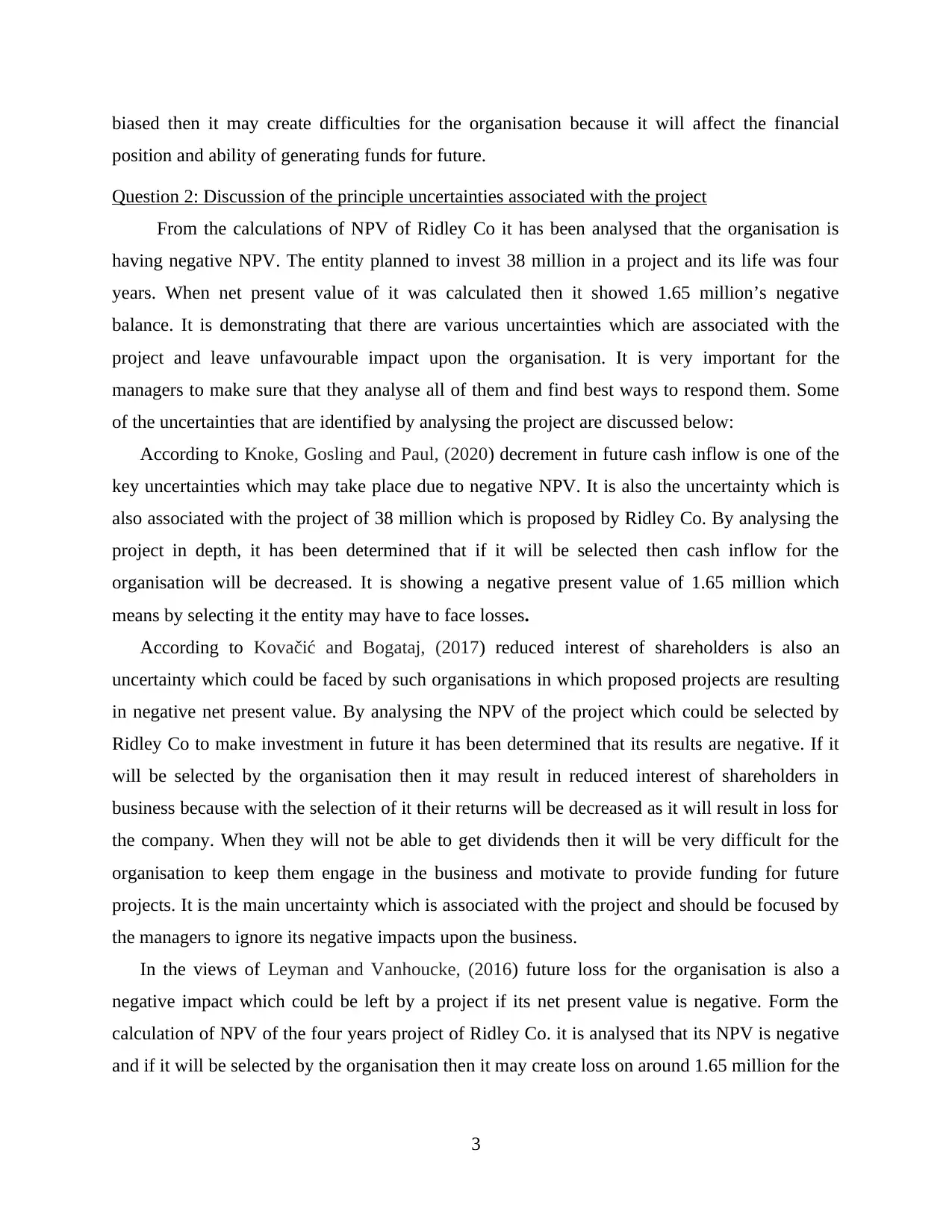
biased then it may create difficulties for the organisation because it will affect the financial
position and ability of generating funds for future.
Question 2: Discussion of the principle uncertainties associated with the project
From the calculations of NPV of Ridley Co it has been analysed that the organisation is
having negative NPV. The entity planned to invest 38 million in a project and its life was four
years. When net present value of it was calculated then it showed 1.65 million’s negative
balance. It is demonstrating that there are various uncertainties which are associated with the
project and leave unfavourable impact upon the organisation. It is very important for the
managers to make sure that they analyse all of them and find best ways to respond them. Some
of the uncertainties that are identified by analysing the project are discussed below:
According to Knoke, Gosling and Paul, (2020) decrement in future cash inflow is one of the
key uncertainties which may take place due to negative NPV. It is also the uncertainty which is
also associated with the project of 38 million which is proposed by Ridley Co. By analysing the
project in depth, it has been determined that if it will be selected then cash inflow for the
organisation will be decreased. It is showing a negative present value of 1.65 million which
means by selecting it the entity may have to face losses.
According to Kovačić and Bogataj, (2017) reduced interest of shareholders is also an
uncertainty which could be faced by such organisations in which proposed projects are resulting
in negative net present value. By analysing the NPV of the project which could be selected by
Ridley Co to make investment in future it has been determined that its results are negative. If it
will be selected by the organisation then it may result in reduced interest of shareholders in
business because with the selection of it their returns will be decreased as it will result in loss for
the company. When they will not be able to get dividends then it will be very difficult for the
organisation to keep them engage in the business and motivate to provide funding for future
projects. It is the main uncertainty which is associated with the project and should be focused by
the managers to ignore its negative impacts upon the business.
In the views of Leyman and Vanhoucke, (2016) future loss for the organisation is also a
negative impact which could be left by a project if its net present value is negative. Form the
calculation of NPV of the four years project of Ridley Co. it is analysed that its NPV is negative
and if it will be selected by the organisation then it may create loss on around 1.65 million for the
3
position and ability of generating funds for future.
Question 2: Discussion of the principle uncertainties associated with the project
From the calculations of NPV of Ridley Co it has been analysed that the organisation is
having negative NPV. The entity planned to invest 38 million in a project and its life was four
years. When net present value of it was calculated then it showed 1.65 million’s negative
balance. It is demonstrating that there are various uncertainties which are associated with the
project and leave unfavourable impact upon the organisation. It is very important for the
managers to make sure that they analyse all of them and find best ways to respond them. Some
of the uncertainties that are identified by analysing the project are discussed below:
According to Knoke, Gosling and Paul, (2020) decrement in future cash inflow is one of the
key uncertainties which may take place due to negative NPV. It is also the uncertainty which is
also associated with the project of 38 million which is proposed by Ridley Co. By analysing the
project in depth, it has been determined that if it will be selected then cash inflow for the
organisation will be decreased. It is showing a negative present value of 1.65 million which
means by selecting it the entity may have to face losses.
According to Kovačić and Bogataj, (2017) reduced interest of shareholders is also an
uncertainty which could be faced by such organisations in which proposed projects are resulting
in negative net present value. By analysing the NPV of the project which could be selected by
Ridley Co to make investment in future it has been determined that its results are negative. If it
will be selected by the organisation then it may result in reduced interest of shareholders in
business because with the selection of it their returns will be decreased as it will result in loss for
the company. When they will not be able to get dividends then it will be very difficult for the
organisation to keep them engage in the business and motivate to provide funding for future
projects. It is the main uncertainty which is associated with the project and should be focused by
the managers to ignore its negative impacts upon the business.
In the views of Leyman and Vanhoucke, (2016) future loss for the organisation is also a
negative impact which could be left by a project if its net present value is negative. Form the
calculation of NPV of the four years project of Ridley Co. it is analysed that its NPV is negative
and if it will be selected by the organisation then it may create loss on around 1.65 million for the
3
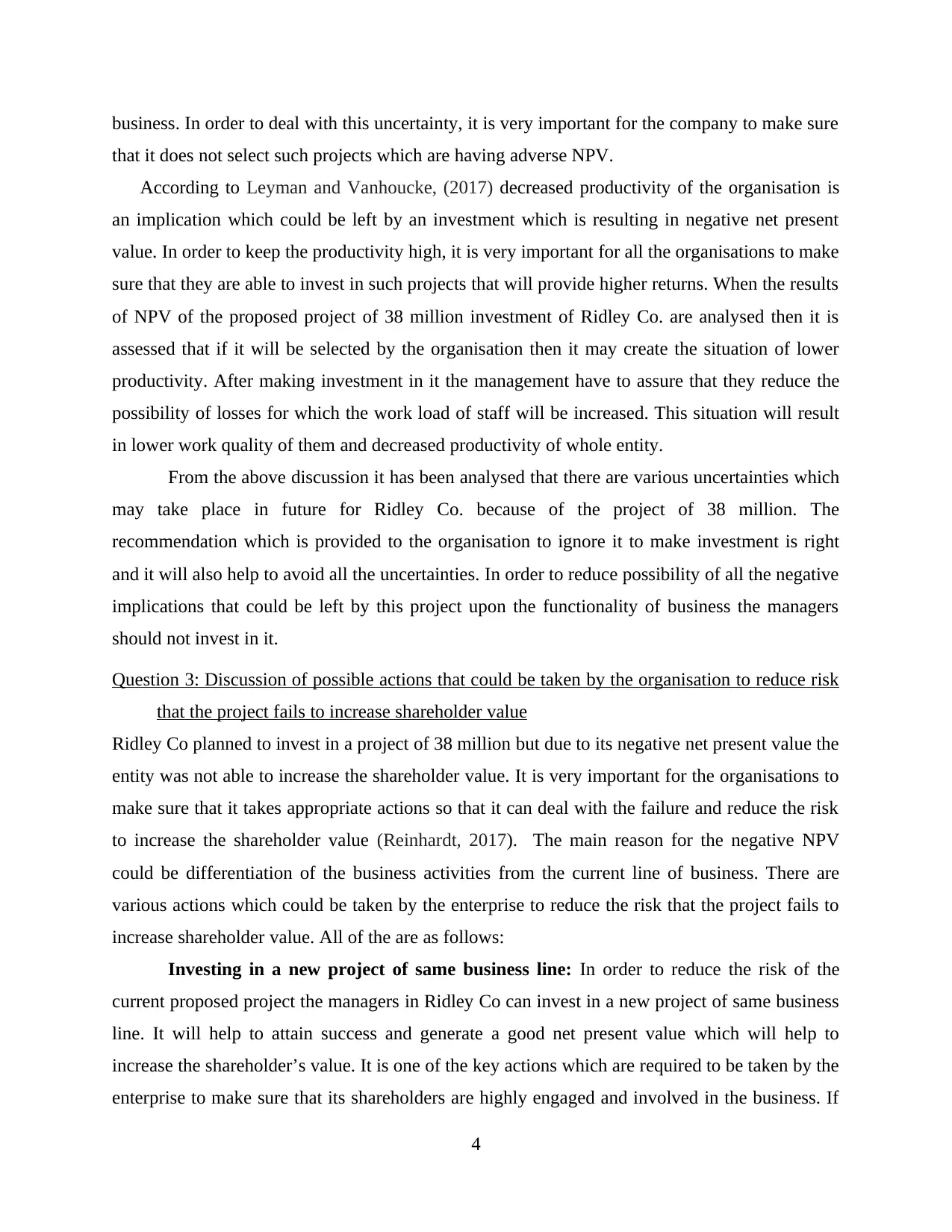
business. In order to deal with this uncertainty, it is very important for the company to make sure
that it does not select such projects which are having adverse NPV.
According to Leyman and Vanhoucke, (2017) decreased productivity of the organisation is
an implication which could be left by an investment which is resulting in negative net present
value. In order to keep the productivity high, it is very important for all the organisations to make
sure that they are able to invest in such projects that will provide higher returns. When the results
of NPV of the proposed project of 38 million investment of Ridley Co. are analysed then it is
assessed that if it will be selected by the organisation then it may create the situation of lower
productivity. After making investment in it the management have to assure that they reduce the
possibility of losses for which the work load of staff will be increased. This situation will result
in lower work quality of them and decreased productivity of whole entity.
From the above discussion it has been analysed that there are various uncertainties which
may take place in future for Ridley Co. because of the project of 38 million. The
recommendation which is provided to the organisation to ignore it to make investment is right
and it will also help to avoid all the uncertainties. In order to reduce possibility of all the negative
implications that could be left by this project upon the functionality of business the managers
should not invest in it.
Question 3: Discussion of possible actions that could be taken by the organisation to reduce risk
that the project fails to increase shareholder value
Ridley Co planned to invest in a project of 38 million but due to its negative net present value the
entity was not able to increase the shareholder value. It is very important for the organisations to
make sure that it takes appropriate actions so that it can deal with the failure and reduce the risk
to increase the shareholder value (Reinhardt, 2017). The main reason for the negative NPV
could be differentiation of the business activities from the current line of business. There are
various actions which could be taken by the enterprise to reduce the risk that the project fails to
increase shareholder value. All of the are as follows:
Investing in a new project of same business line: In order to reduce the risk of the
current proposed project the managers in Ridley Co can invest in a new project of same business
line. It will help to attain success and generate a good net present value which will help to
increase the shareholder’s value. It is one of the key actions which are required to be taken by the
enterprise to make sure that its shareholders are highly engaged and involved in the business. If
4
that it does not select such projects which are having adverse NPV.
According to Leyman and Vanhoucke, (2017) decreased productivity of the organisation is
an implication which could be left by an investment which is resulting in negative net present
value. In order to keep the productivity high, it is very important for all the organisations to make
sure that they are able to invest in such projects that will provide higher returns. When the results
of NPV of the proposed project of 38 million investment of Ridley Co. are analysed then it is
assessed that if it will be selected by the organisation then it may create the situation of lower
productivity. After making investment in it the management have to assure that they reduce the
possibility of losses for which the work load of staff will be increased. This situation will result
in lower work quality of them and decreased productivity of whole entity.
From the above discussion it has been analysed that there are various uncertainties which
may take place in future for Ridley Co. because of the project of 38 million. The
recommendation which is provided to the organisation to ignore it to make investment is right
and it will also help to avoid all the uncertainties. In order to reduce possibility of all the negative
implications that could be left by this project upon the functionality of business the managers
should not invest in it.
Question 3: Discussion of possible actions that could be taken by the organisation to reduce risk
that the project fails to increase shareholder value
Ridley Co planned to invest in a project of 38 million but due to its negative net present value the
entity was not able to increase the shareholder value. It is very important for the organisations to
make sure that it takes appropriate actions so that it can deal with the failure and reduce the risk
to increase the shareholder value (Reinhardt, 2017). The main reason for the negative NPV
could be differentiation of the business activities from the current line of business. There are
various actions which could be taken by the enterprise to reduce the risk that the project fails to
increase shareholder value. All of the are as follows:
Investing in a new project of same business line: In order to reduce the risk of the
current proposed project the managers in Ridley Co can invest in a new project of same business
line. It will help to attain success and generate a good net present value which will help to
increase the shareholder’s value. It is one of the key actions which are required to be taken by the
enterprise to make sure that its shareholders are highly engaged and involved in the business. If
4
⊘ This is a preview!⊘
Do you want full access?
Subscribe today to unlock all pages.

Trusted by 1+ million students worldwide
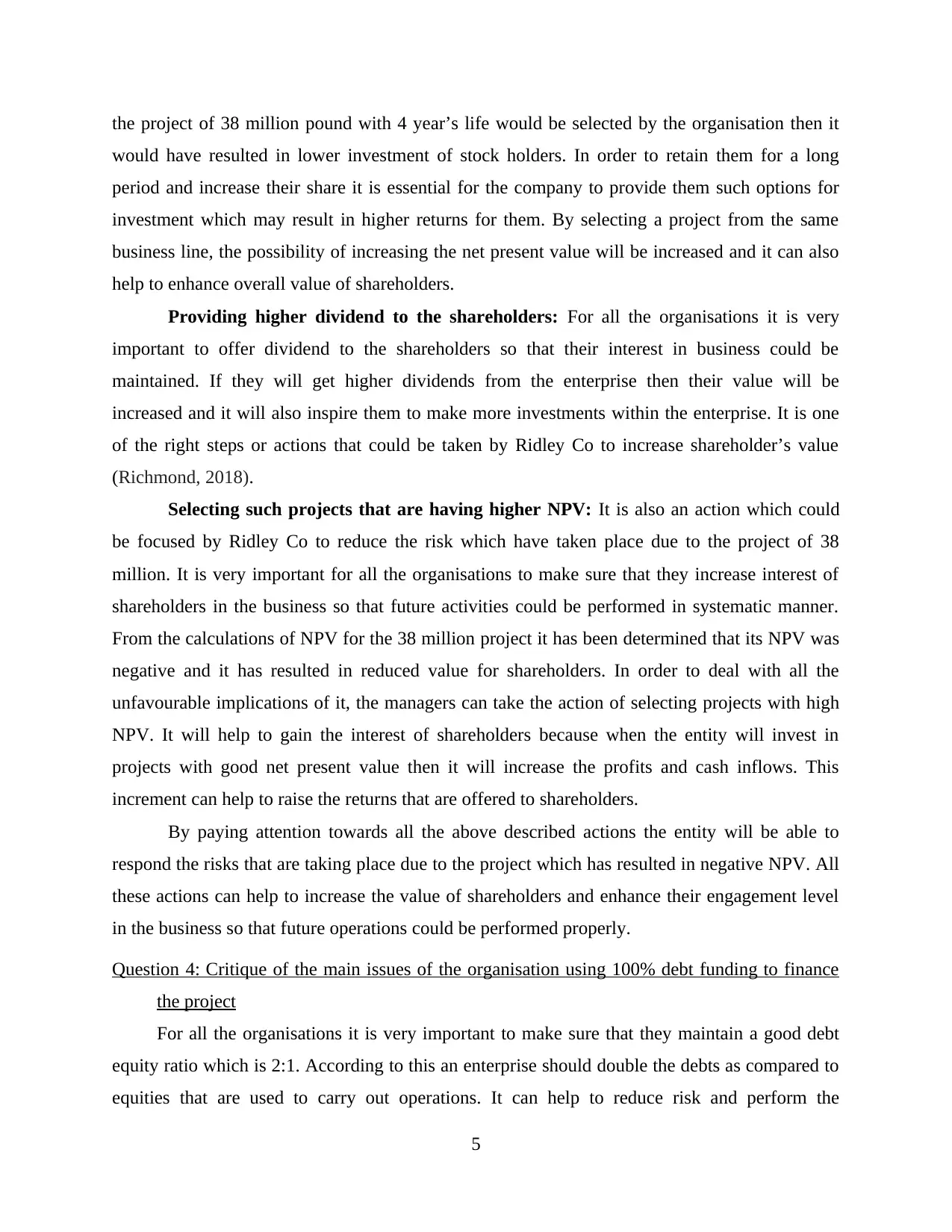
the project of 38 million pound with 4 year’s life would be selected by the organisation then it
would have resulted in lower investment of stock holders. In order to retain them for a long
period and increase their share it is essential for the company to provide them such options for
investment which may result in higher returns for them. By selecting a project from the same
business line, the possibility of increasing the net present value will be increased and it can also
help to enhance overall value of shareholders.
Providing higher dividend to the shareholders: For all the organisations it is very
important to offer dividend to the shareholders so that their interest in business could be
maintained. If they will get higher dividends from the enterprise then their value will be
increased and it will also inspire them to make more investments within the enterprise. It is one
of the right steps or actions that could be taken by Ridley Co to increase shareholder’s value
(Richmond, 2018).
Selecting such projects that are having higher NPV: It is also an action which could
be focused by Ridley Co to reduce the risk which have taken place due to the project of 38
million. It is very important for all the organisations to make sure that they increase interest of
shareholders in the business so that future activities could be performed in systematic manner.
From the calculations of NPV for the 38 million project it has been determined that its NPV was
negative and it has resulted in reduced value for shareholders. In order to deal with all the
unfavourable implications of it, the managers can take the action of selecting projects with high
NPV. It will help to gain the interest of shareholders because when the entity will invest in
projects with good net present value then it will increase the profits and cash inflows. This
increment can help to raise the returns that are offered to shareholders.
By paying attention towards all the above described actions the entity will be able to
respond the risks that are taking place due to the project which has resulted in negative NPV. All
these actions can help to increase the value of shareholders and enhance their engagement level
in the business so that future operations could be performed properly.
Question 4: Critique of the main issues of the organisation using 100% debt funding to finance
the project
For all the organisations it is very important to make sure that they maintain a good debt
equity ratio which is 2:1. According to this an enterprise should double the debts as compared to
equities that are used to carry out operations. It can help to reduce risk and perform the
5
would have resulted in lower investment of stock holders. In order to retain them for a long
period and increase their share it is essential for the company to provide them such options for
investment which may result in higher returns for them. By selecting a project from the same
business line, the possibility of increasing the net present value will be increased and it can also
help to enhance overall value of shareholders.
Providing higher dividend to the shareholders: For all the organisations it is very
important to offer dividend to the shareholders so that their interest in business could be
maintained. If they will get higher dividends from the enterprise then their value will be
increased and it will also inspire them to make more investments within the enterprise. It is one
of the right steps or actions that could be taken by Ridley Co to increase shareholder’s value
(Richmond, 2018).
Selecting such projects that are having higher NPV: It is also an action which could
be focused by Ridley Co to reduce the risk which have taken place due to the project of 38
million. It is very important for all the organisations to make sure that they increase interest of
shareholders in the business so that future activities could be performed in systematic manner.
From the calculations of NPV for the 38 million project it has been determined that its NPV was
negative and it has resulted in reduced value for shareholders. In order to deal with all the
unfavourable implications of it, the managers can take the action of selecting projects with high
NPV. It will help to gain the interest of shareholders because when the entity will invest in
projects with good net present value then it will increase the profits and cash inflows. This
increment can help to raise the returns that are offered to shareholders.
By paying attention towards all the above described actions the entity will be able to
respond the risks that are taking place due to the project which has resulted in negative NPV. All
these actions can help to increase the value of shareholders and enhance their engagement level
in the business so that future operations could be performed properly.
Question 4: Critique of the main issues of the organisation using 100% debt funding to finance
the project
For all the organisations it is very important to make sure that they maintain a good debt
equity ratio which is 2:1. According to this an enterprise should double the debts as compared to
equities that are used to carry out operations. It can help to reduce risk and perform the
5
Paraphrase This Document
Need a fresh take? Get an instant paraphrase of this document with our AI Paraphraser
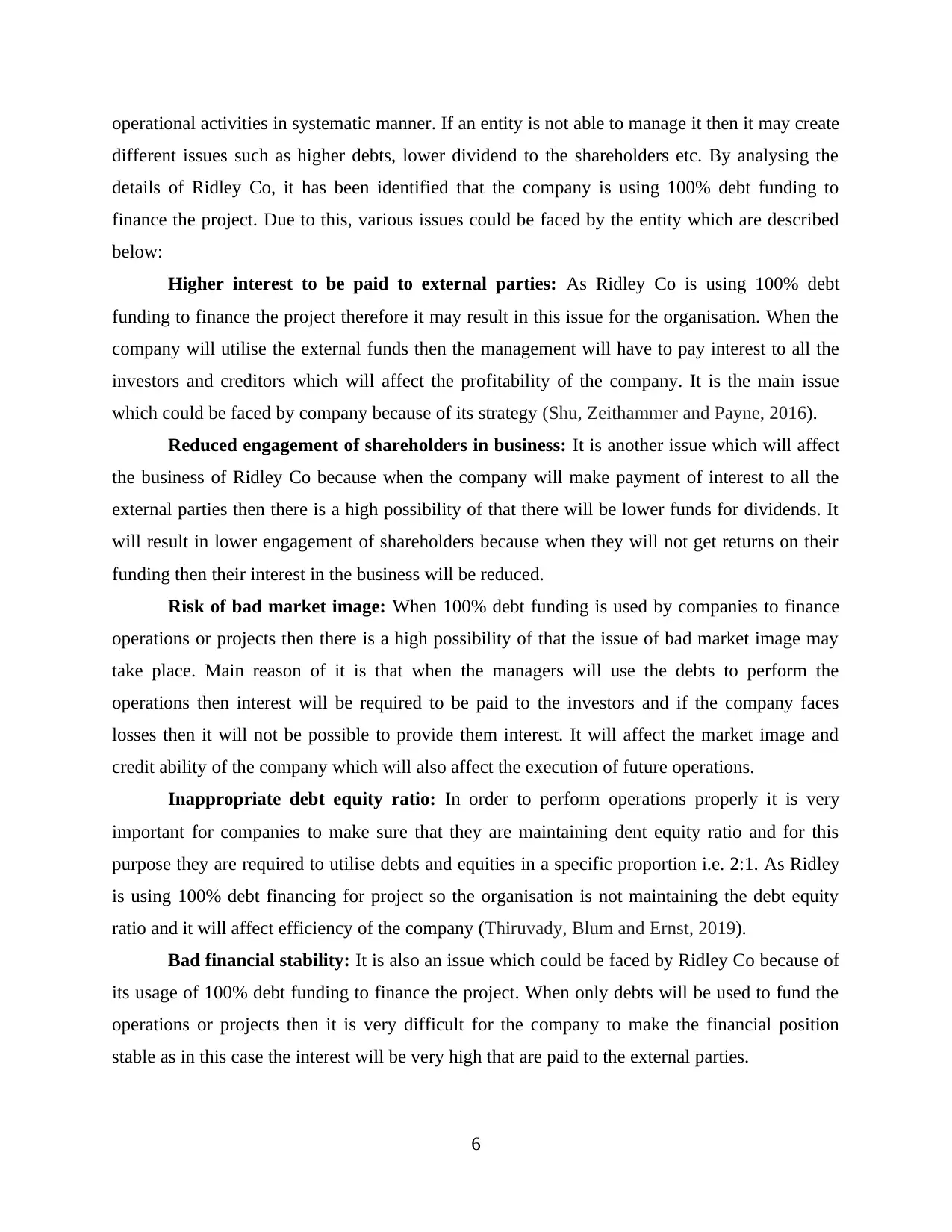
operational activities in systematic manner. If an entity is not able to manage it then it may create
different issues such as higher debts, lower dividend to the shareholders etc. By analysing the
details of Ridley Co, it has been identified that the company is using 100% debt funding to
finance the project. Due to this, various issues could be faced by the entity which are described
below:
Higher interest to be paid to external parties: As Ridley Co is using 100% debt
funding to finance the project therefore it may result in this issue for the organisation. When the
company will utilise the external funds then the management will have to pay interest to all the
investors and creditors which will affect the profitability of the company. It is the main issue
which could be faced by company because of its strategy (Shu, Zeithammer and Payne, 2016).
Reduced engagement of shareholders in business: It is another issue which will affect
the business of Ridley Co because when the company will make payment of interest to all the
external parties then there is a high possibility of that there will be lower funds for dividends. It
will result in lower engagement of shareholders because when they will not get returns on their
funding then their interest in the business will be reduced.
Risk of bad market image: When 100% debt funding is used by companies to finance
operations or projects then there is a high possibility of that the issue of bad market image may
take place. Main reason of it is that when the managers will use the debts to perform the
operations then interest will be required to be paid to the investors and if the company faces
losses then it will not be possible to provide them interest. It will affect the market image and
credit ability of the company which will also affect the execution of future operations.
Inappropriate debt equity ratio: In order to perform operations properly it is very
important for companies to make sure that they are maintaining dent equity ratio and for this
purpose they are required to utilise debts and equities in a specific proportion i.e. 2:1. As Ridley
is using 100% debt financing for project so the organisation is not maintaining the debt equity
ratio and it will affect efficiency of the company (Thiruvady, Blum and Ernst, 2019).
Bad financial stability: It is also an issue which could be faced by Ridley Co because of
its usage of 100% debt funding to finance the project. When only debts will be used to fund the
operations or projects then it is very difficult for the company to make the financial position
stable as in this case the interest will be very high that are paid to the external parties.
6
different issues such as higher debts, lower dividend to the shareholders etc. By analysing the
details of Ridley Co, it has been identified that the company is using 100% debt funding to
finance the project. Due to this, various issues could be faced by the entity which are described
below:
Higher interest to be paid to external parties: As Ridley Co is using 100% debt
funding to finance the project therefore it may result in this issue for the organisation. When the
company will utilise the external funds then the management will have to pay interest to all the
investors and creditors which will affect the profitability of the company. It is the main issue
which could be faced by company because of its strategy (Shu, Zeithammer and Payne, 2016).
Reduced engagement of shareholders in business: It is another issue which will affect
the business of Ridley Co because when the company will make payment of interest to all the
external parties then there is a high possibility of that there will be lower funds for dividends. It
will result in lower engagement of shareholders because when they will not get returns on their
funding then their interest in the business will be reduced.
Risk of bad market image: When 100% debt funding is used by companies to finance
operations or projects then there is a high possibility of that the issue of bad market image may
take place. Main reason of it is that when the managers will use the debts to perform the
operations then interest will be required to be paid to the investors and if the company faces
losses then it will not be possible to provide them interest. It will affect the market image and
credit ability of the company which will also affect the execution of future operations.
Inappropriate debt equity ratio: In order to perform operations properly it is very
important for companies to make sure that they are maintaining dent equity ratio and for this
purpose they are required to utilise debts and equities in a specific proportion i.e. 2:1. As Ridley
is using 100% debt financing for project so the organisation is not maintaining the debt equity
ratio and it will affect efficiency of the company (Thiruvady, Blum and Ernst, 2019).
Bad financial stability: It is also an issue which could be faced by Ridley Co because of
its usage of 100% debt funding to finance the project. When only debts will be used to fund the
operations or projects then it is very difficult for the company to make the financial position
stable as in this case the interest will be very high that are paid to the external parties.
6
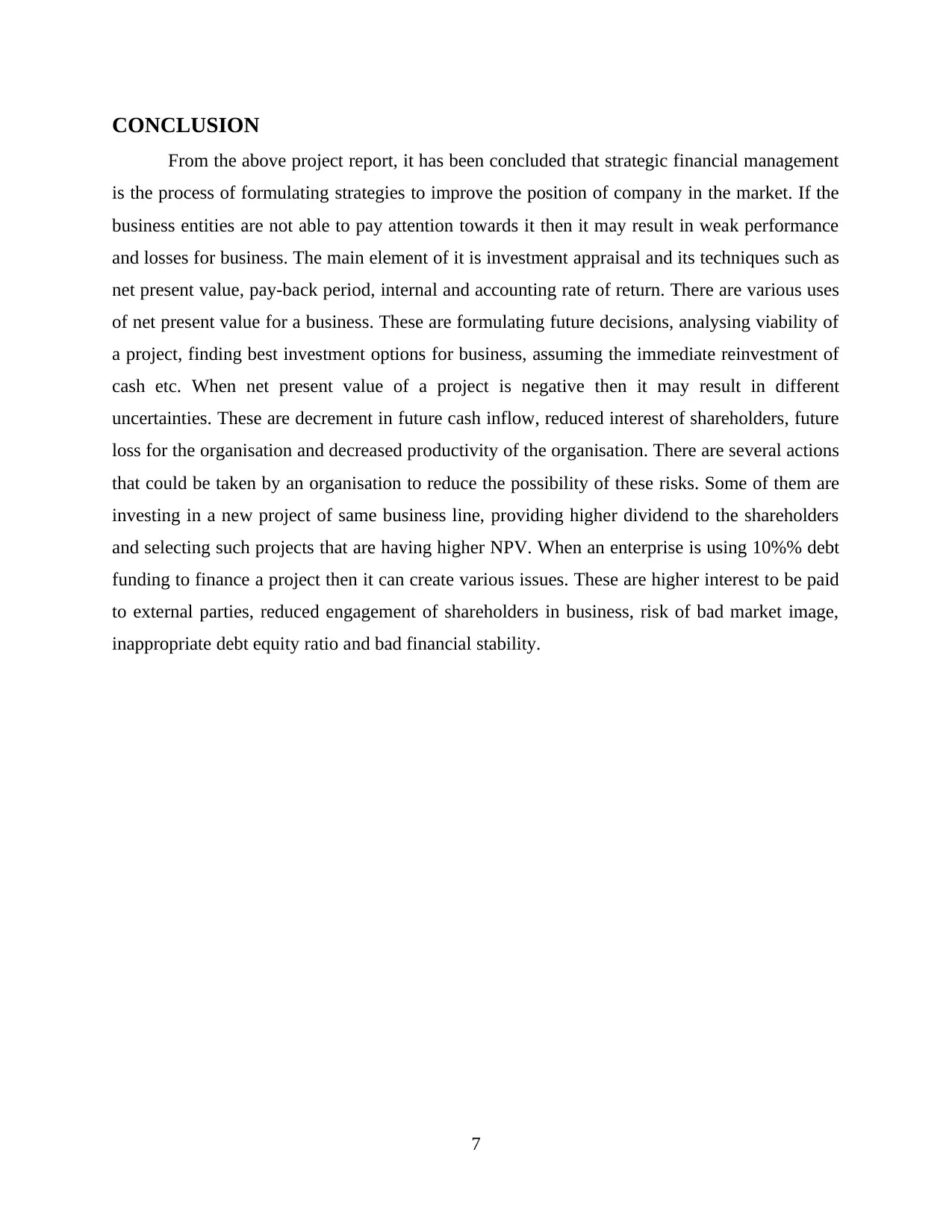
CONCLUSION
From the above project report, it has been concluded that strategic financial management
is the process of formulating strategies to improve the position of company in the market. If the
business entities are not able to pay attention towards it then it may result in weak performance
and losses for business. The main element of it is investment appraisal and its techniques such as
net present value, pay-back period, internal and accounting rate of return. There are various uses
of net present value for a business. These are formulating future decisions, analysing viability of
a project, finding best investment options for business, assuming the immediate reinvestment of
cash etc. When net present value of a project is negative then it may result in different
uncertainties. These are decrement in future cash inflow, reduced interest of shareholders, future
loss for the organisation and decreased productivity of the organisation. There are several actions
that could be taken by an organisation to reduce the possibility of these risks. Some of them are
investing in a new project of same business line, providing higher dividend to the shareholders
and selecting such projects that are having higher NPV. When an enterprise is using 10%% debt
funding to finance a project then it can create various issues. These are higher interest to be paid
to external parties, reduced engagement of shareholders in business, risk of bad market image,
inappropriate debt equity ratio and bad financial stability.
7
From the above project report, it has been concluded that strategic financial management
is the process of formulating strategies to improve the position of company in the market. If the
business entities are not able to pay attention towards it then it may result in weak performance
and losses for business. The main element of it is investment appraisal and its techniques such as
net present value, pay-back period, internal and accounting rate of return. There are various uses
of net present value for a business. These are formulating future decisions, analysing viability of
a project, finding best investment options for business, assuming the immediate reinvestment of
cash etc. When net present value of a project is negative then it may result in different
uncertainties. These are decrement in future cash inflow, reduced interest of shareholders, future
loss for the organisation and decreased productivity of the organisation. There are several actions
that could be taken by an organisation to reduce the possibility of these risks. Some of them are
investing in a new project of same business line, providing higher dividend to the shareholders
and selecting such projects that are having higher NPV. When an enterprise is using 10%% debt
funding to finance a project then it can create various issues. These are higher interest to be paid
to external parties, reduced engagement of shareholders in business, risk of bad market image,
inappropriate debt equity ratio and bad financial stability.
7
⊘ This is a preview!⊘
Do you want full access?
Subscribe today to unlock all pages.

Trusted by 1+ million students worldwide
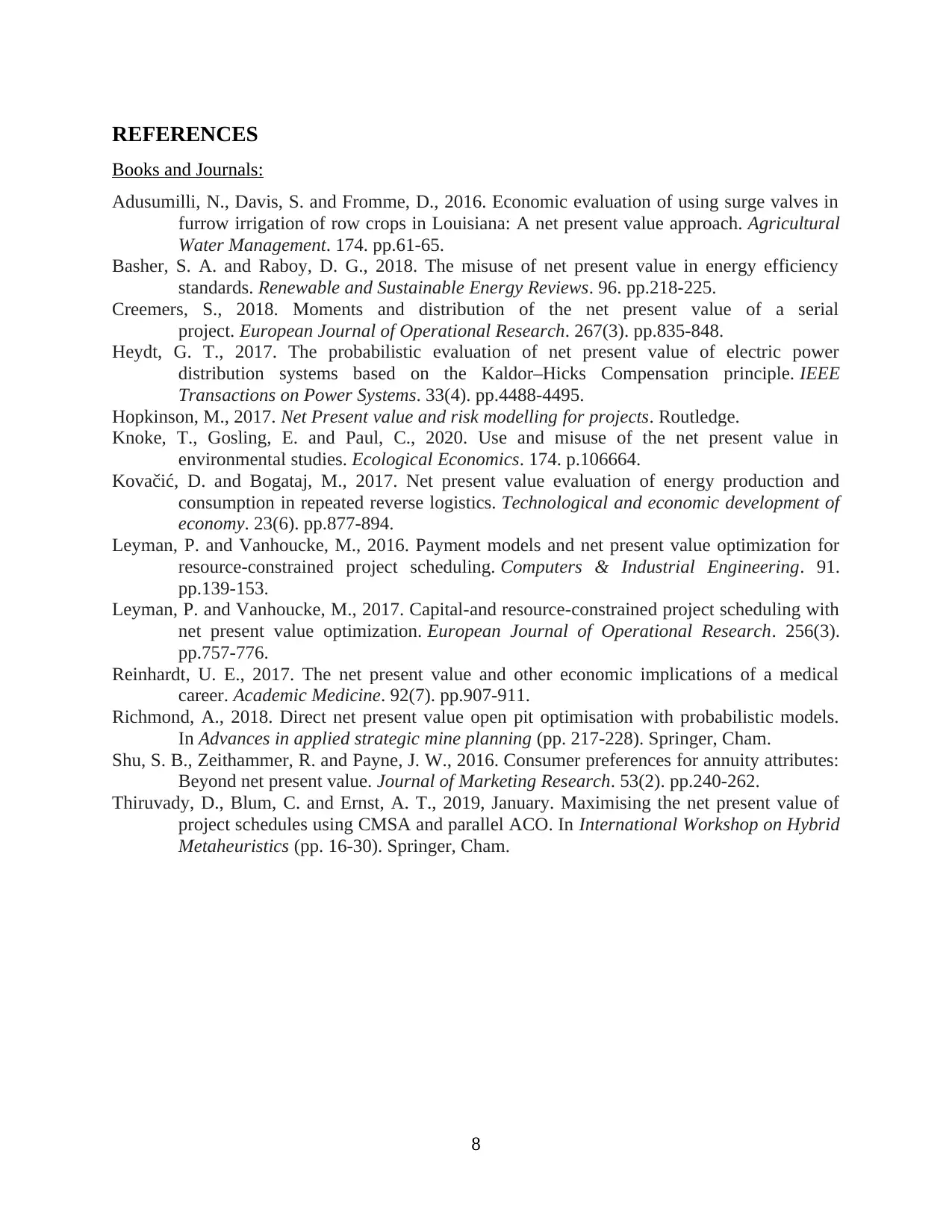
REFERENCES
Books and Journals:
Adusumilli, N., Davis, S. and Fromme, D., 2016. Economic evaluation of using surge valves in
furrow irrigation of row crops in Louisiana: A net present value approach. Agricultural
Water Management. 174. pp.61-65.
Basher, S. A. and Raboy, D. G., 2018. The misuse of net present value in energy efficiency
standards. Renewable and Sustainable Energy Reviews. 96. pp.218-225.
Creemers, S., 2018. Moments and distribution of the net present value of a serial
project. European Journal of Operational Research. 267(3). pp.835-848.
Heydt, G. T., 2017. The probabilistic evaluation of net present value of electric power
distribution systems based on the Kaldor–Hicks Compensation principle. IEEE
Transactions on Power Systems. 33(4). pp.4488-4495.
Hopkinson, M., 2017. Net Present value and risk modelling for projects. Routledge.
Knoke, T., Gosling, E. and Paul, C., 2020. Use and misuse of the net present value in
environmental studies. Ecological Economics. 174. p.106664.
Kovačić, D. and Bogataj, M., 2017. Net present value evaluation of energy production and
consumption in repeated reverse logistics. Technological and economic development of
economy. 23(6). pp.877-894.
Leyman, P. and Vanhoucke, M., 2016. Payment models and net present value optimization for
resource-constrained project scheduling. Computers & Industrial Engineering. 91.
pp.139-153.
Leyman, P. and Vanhoucke, M., 2017. Capital-and resource-constrained project scheduling with
net present value optimization. European Journal of Operational Research. 256(3).
pp.757-776.
Reinhardt, U. E., 2017. The net present value and other economic implications of a medical
career. Academic Medicine. 92(7). pp.907-911.
Richmond, A., 2018. Direct net present value open pit optimisation with probabilistic models.
In Advances in applied strategic mine planning (pp. 217-228). Springer, Cham.
Shu, S. B., Zeithammer, R. and Payne, J. W., 2016. Consumer preferences for annuity attributes:
Beyond net present value. Journal of Marketing Research. 53(2). pp.240-262.
Thiruvady, D., Blum, C. and Ernst, A. T., 2019, January. Maximising the net present value of
project schedules using CMSA and parallel ACO. In International Workshop on Hybrid
Metaheuristics (pp. 16-30). Springer, Cham.
8
Books and Journals:
Adusumilli, N., Davis, S. and Fromme, D., 2016. Economic evaluation of using surge valves in
furrow irrigation of row crops in Louisiana: A net present value approach. Agricultural
Water Management. 174. pp.61-65.
Basher, S. A. and Raboy, D. G., 2018. The misuse of net present value in energy efficiency
standards. Renewable and Sustainable Energy Reviews. 96. pp.218-225.
Creemers, S., 2018. Moments and distribution of the net present value of a serial
project. European Journal of Operational Research. 267(3). pp.835-848.
Heydt, G. T., 2017. The probabilistic evaluation of net present value of electric power
distribution systems based on the Kaldor–Hicks Compensation principle. IEEE
Transactions on Power Systems. 33(4). pp.4488-4495.
Hopkinson, M., 2017. Net Present value and risk modelling for projects. Routledge.
Knoke, T., Gosling, E. and Paul, C., 2020. Use and misuse of the net present value in
environmental studies. Ecological Economics. 174. p.106664.
Kovačić, D. and Bogataj, M., 2017. Net present value evaluation of energy production and
consumption in repeated reverse logistics. Technological and economic development of
economy. 23(6). pp.877-894.
Leyman, P. and Vanhoucke, M., 2016. Payment models and net present value optimization for
resource-constrained project scheduling. Computers & Industrial Engineering. 91.
pp.139-153.
Leyman, P. and Vanhoucke, M., 2017. Capital-and resource-constrained project scheduling with
net present value optimization. European Journal of Operational Research. 256(3).
pp.757-776.
Reinhardt, U. E., 2017. The net present value and other economic implications of a medical
career. Academic Medicine. 92(7). pp.907-911.
Richmond, A., 2018. Direct net present value open pit optimisation with probabilistic models.
In Advances in applied strategic mine planning (pp. 217-228). Springer, Cham.
Shu, S. B., Zeithammer, R. and Payne, J. W., 2016. Consumer preferences for annuity attributes:
Beyond net present value. Journal of Marketing Research. 53(2). pp.240-262.
Thiruvady, D., Blum, C. and Ernst, A. T., 2019, January. Maximising the net present value of
project schedules using CMSA and parallel ACO. In International Workshop on Hybrid
Metaheuristics (pp. 16-30). Springer, Cham.
8
1 out of 10
Related Documents
Your All-in-One AI-Powered Toolkit for Academic Success.
+13062052269
info@desklib.com
Available 24*7 on WhatsApp / Email
![[object Object]](/_next/static/media/star-bottom.7253800d.svg)
Unlock your academic potential
Copyright © 2020–2025 A2Z Services. All Rights Reserved. Developed and managed by ZUCOL.





